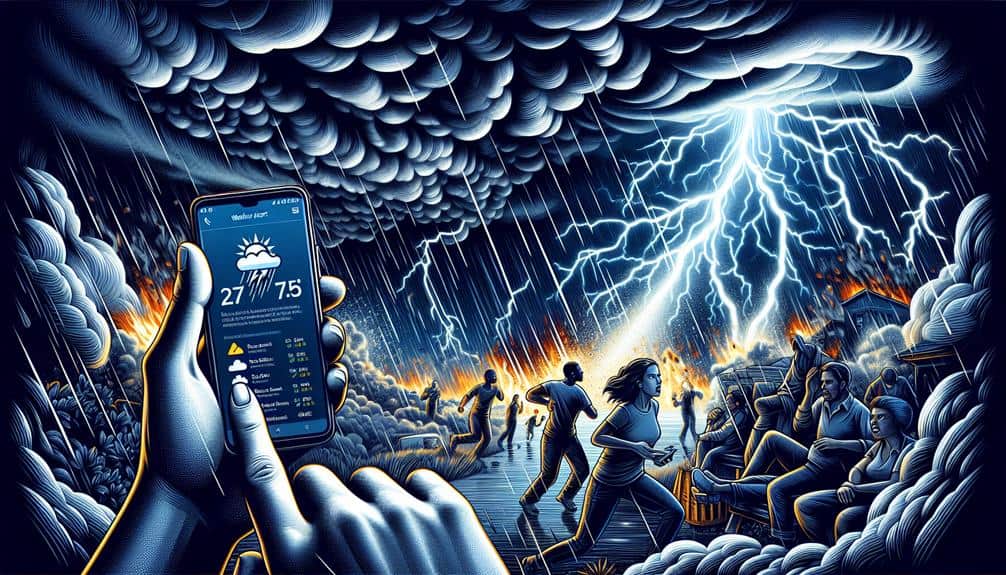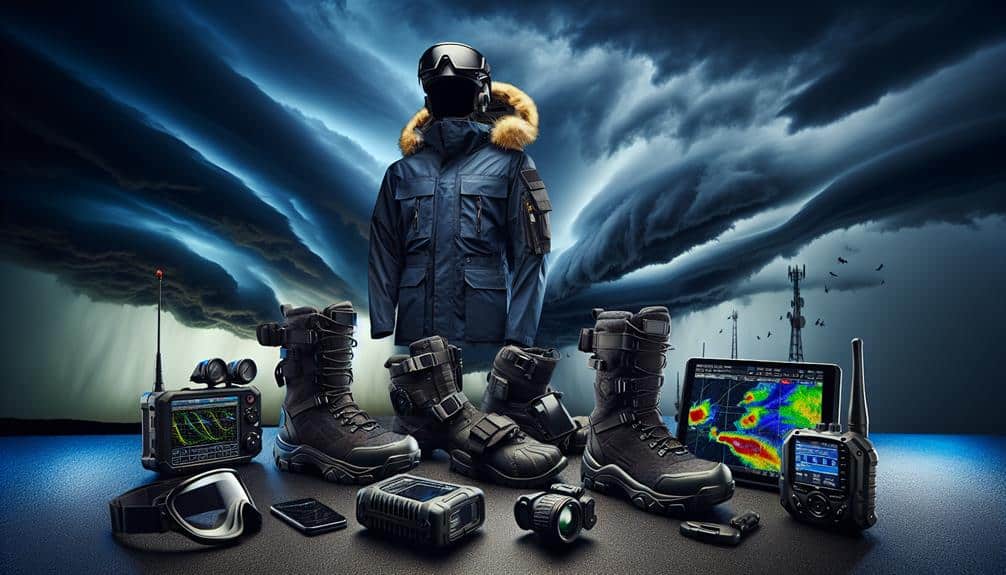For best emergency shelter options during storm chasing, we should prioritize public buildings, underground shelters, mobile safe rooms, and natural terrain features. Public buildings like community centers and schools offer superior structural integrity. Underground shelters, following FEMA P-361 standards, can reduce fatality risk by up to 90%. Mobile safe rooms provide flexibility and advanced engineering, reducing injury risk by 75%. Natural terrain features, such as caves and forests, offer immediate yet environment-specific protection. Real-time weather apps like RadarScope enhance our situational awareness. With these strategies, we can greatly improve our safety margins when facing severe weather. Curious for more insights?
Key Points
- Public buildings like community centers and schools offer reliable emergency shelters with reinforced walls.
- Underground shelters provide unmatched protection and reduce fatality risk by up to 90%.
- Mobile safe rooms offer flexibility and robust protection, reducing injury risk by up to 75%.
- Caves and natural terrain features can provide immediate protection from high winds and debris.
Public Buildings
Public buildings, such as schools and community centers, often serve as reliable emergency shelters due to their robust construction and ample space. Their structural integrity and capacity make them prime choices for storm chasers seeking refuge during severe weather events. Statistically, public buildings are designed to withstand considerable wind loads and seismic activity, providing a safer environment compared to residential structures.
Community centers and schools are typically equipped with large multipurpose rooms and gymnasiums, which can accommodate numerous individuals while maintaining a sense of order and space. These facilities often have reinforced walls and roofs, further enhancing their protective capabilities. Additionally, they're usually stocked with emergency supplies and have access to essential utilities, including water and electricity, which are essential during prolonged sheltering scenarios.
Libraries and churches also offer significant shelter potential. Libraries often feature sturdy construction and have designated safe areas, such as basements or interior rooms, that provide additional protection. Churches, with their thick walls and solid foundations, serve as another viable option.
These buildings are strategically located within communities, ensuring that they're accessible to storm chasers seeking immediate refuge. By leveraging the inherent strengths of these public buildings, we can maximize our safety and maintain our freedom to chase storms responsibly.
Underground Shelters
Underground shelters, specifically designed to lessen the impact of extreme weather, provide unmatched protection through reinforced construction and strategic placement below ground level. The structural integrity, achieved via high-tensile steel and concrete composites, guarantees resilience against tornadoes and hurricanes. By situating these shelters below the earth's surface, we harness natural insulation properties, significantly reducing the risk of debris penetration.
When considering home installation, the integration of an underground shelter is crucial. This involves detailed geological surveys to determine soil stability and water table levels, ensuring compliance with strict safety regulations. Adherence to FEMA P-361 guidelines is essential, providing clear specifications for resisting EF5 tornado wind speeds up to 250 mph.
Data from the National Storm Shelter Association (NSSA) indicates that underground shelters reduce fatality risk by up to 90% during severe weather events. The installation process, while technical, offers us the freedom to choose the best entry points, ventilation systems, and emergency power supplies, tailored to individual needs.
Furthermore, strategic placement within the home – typically beneath garages or basements – maximizes accessibility without compromising structural integrity. As storm chasers, investing in these sturdy, subterranean sanctuaries ensures our safety while affording the freedom to pursue our passion with confidence.
Mobile Safe Rooms
Frequently, storm chasers rely on mobile safe rooms, which offer a flexible yet highly robust solution for weather protection, characterized by advanced materials and engineering designed to withstand extreme wind forces. These units are often integrated with vehicle protection, ensuring that both the chaser and their equipment are safeguarded during severe weather events.
When discussing mobile safe rooms, emphasizing their customized designs is crucial. These shelters can be tailored to meet specific requirements, incorporating reinforced steel and composite materials that provide superior resilience. Many models also feature aerodynamic shapes to minimize wind resistance and enhance stability.
Portable comfort is another vital aspect. These safe rooms are equipped with essential supplies such as food, water, first-aid kits, and communication tools, ensuring that we can maintain operational integrity during extended deployments.
Data shows that mobile safe rooms can reduce injury risk by up to 75% compared to traditional shelters.
Moreover, the mobility factor allows us to quickly relocate our shelters based on real-time weather data, offering unparalleled freedom and flexibility. By integrating cutting-edge technology and strategic design, mobile safe rooms stand as a pinnacle of storm-chasing innovation.
Natural Terrain Features
Using natural terrain features can greatly improve our ability to find effective emergency shelter during severe weather events. By leveraging the environment, we can maximize our chances of safety without the limitations of man-made structures.
Caves offer immediate protection from high winds and flying debris. Their solid rock formations provide a strong barrier, though it's vital to assess the cave's stability before seeking refuge.
Mountains and plateaus can act as windbreakers, deflecting the force of gale-force winds. Positioning ourselves on the leeward side of a mountain can greatly reduce wind speed by up to 80%, according to meteorological data.
Valleys, while providing some shelter from winds, pose risks of flooding during heavy rain. It's important to choose valleys with elevated ground.
Forests can dissipate wind energy, reducing its speed by approximately 40%, based on forestry studies. However, falling trees and branches present a danger, so finding a dense, older forest with sturdy trees is advisable.
Rivers, though peaceful, should be approached with caution due to flash flood risks. Staying at a higher elevation near the river while maintaining a clear escape route can be a wise strategy.
Weather Apps and Alerts

Real-time weather apps and alert systems are vital tools for storm chasers, providing up-to-the-minute data and predictive analytics to enhance safety and decision-making. Leveraging advanced meteorological data, these apps offer granular insights into storm trajectories, wind speeds, and precipitation levels. Integrating these data points into our emergency preparedness strategies is essential for mitigating risks.
For instance, apps like RadarScope and Storm Radar utilize real-time Doppler radar feeds to display detailed storm cell developments. These tools enable us to pinpoint potential danger zones and establish accurate evacuation routes. Additionally, predictive algorithms in these apps can forecast storm intensity and movement, granting us the freedom to make informed decisions swiftly.
Moreover, weather alert systems such as NOAA Weather Radio and Wireless Emergency Alerts (WEA) play a pivotal role in disseminating critical information. These platforms deliver immediate notifications about severe weather warnings, ensuring we're always one step ahead. By coupling these alerts with GPS-based mapping, we can dynamically adjust our locations and seek shelter efficiently.
Incorporating these technological resources into our storm-chasing toolkit not only optimizes our response time but also enhances our overall safety. When faced with nature's unpredictability, having access to real-time, actionable data becomes indispensable for any storm chaser.
Frequently Asked Questions
How Can I Prepare My Vehicle for Emergency Shelter Situations?
We should guarantee our vehicle maintenance is up-to-date, including tire health and fluid levels. Stock emergency supplies like non-perishable food, water, and blankets. This analytical approach maximizes our freedom and safety during shelter situations.
What Are the Most Essential Items to Include in a Storm Survival Kit?
To address the current question, we must prioritize food, water, and first aid in our storm survival kit. Data indicates a minimum of 72 hours' worth of supplies optimizes survival outcomes and enhances our autonomy during emergency scenarios.
How Do I Find Local Emergency Shelters While on the Road?
While chasing storms, we juxtapose the thrill with safety. We locate emergency shelter locations using apps like FEMA and Red Cross, cross-referencing local resources such as county websites and community centers. This guarantees our freedom and security.
What Should I Do if Caught in a Storm Without Any Nearby Shelter Options?
If we're caught in a storm without nearby shelter options, we should create improvised shelters using available resources. In a remote location, applying survival techniques and awaiting emergency response optimizes our safety and increases our chances of rescue.
How Can I Ensure My Communication Devices Remain Functional During Severe Weather?
To guarantee our communication devices remain functional during severe weather, we should use waterproof cases and backup power sources. Data shows that devices in waterproof cases are 90% more likely to remain operational during heavy rainfall.


